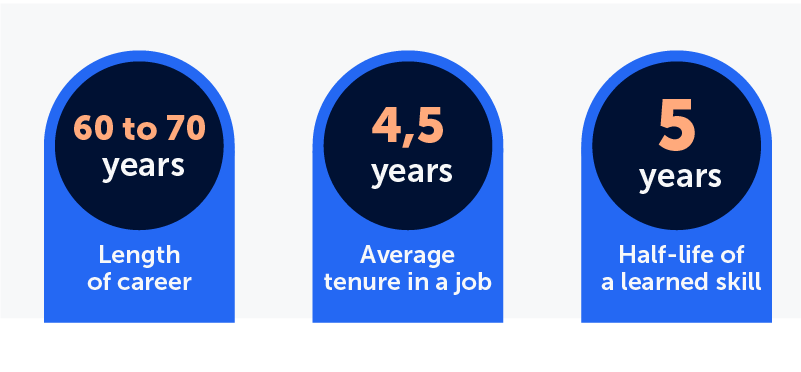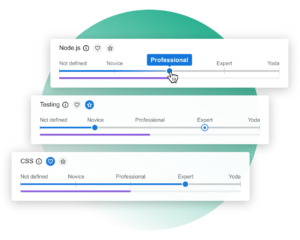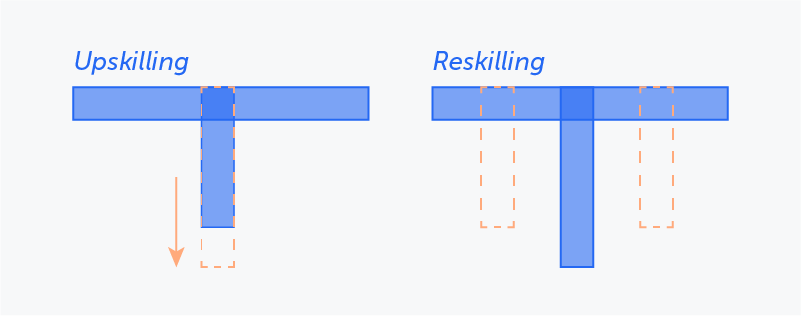Upskilling
Learn what is upskilling and what benefits it has. Discover examples and how to plan upskilling program for your team using different methods and tools.

In a dynamic business environment, it’s more important than ever for organizations to keep their teams’ skills sharp. As digital transformation reshapes how we work, offering well-rounded upskilling programs helps businesses stay ahead and ensure their workforce is ready for the future.
In this article, we will cover:
- What is upskilling?
- Why upskilling is more critical than ever
- Benefits of upskilling employees
- How to upskill employees
- Examples of upskilling areas to focus on
- The difference between upskilling and reskilling
- Methods and tools of upskilling
What is upskilling?
Upskilling is improving an individual’s skill set, making them a more effective employee. Typically upskilling occurs through employee development (i.e., education or additional training), with organizations providing new opportunities based on improving abilities.
Examples of upskilling include both soft skills and technical knowledge. By upskilling employees, management could choose to enhance their team’s emotional intelligence and improve collaboration in the work environment, or they could target a specific technical skill missing from their workforce.
On a basic level, upskilling is investing in your workforce to meet the changing demands of a business. Given recent dramatic changes caused by the pandemic and new technologies, upskilling has become a growing focus for many organizations.
A survey found that 42% of companies have increased their upskilling and reskilling programs since the pandemic.
Businesses must learn to adapt and operate in the new digital economy. Often referred to as “digital upskilling,” this means retraining staff members on new technologies and working methods that make the most of them.
Beyond simply improving employee skillsets, many organizations see upskilling as a cultural shift required to compete in the digital age.
Nowadays, organizations must possess a lifelong learning mentality that constantly looks for ways to improve, collaborate, and engage with customers using new technology.
Alongside reskilling, upskilling has become a critical tool in modern business strategy.

How to conduct a skills gap analysis and what to do next
Start building your foundation for strategic workforce development.
Download guideWhy upskilling is more important than ever
Employee development and teaching team new skills to improve operations have always been vital to business success. But rapid advances in new technologies (e.g., AI and automation) and greater digital integration mean companies require upskilling now more than ever.
Many traditional business activities and their associated skillsets have become outdated. To remain successful, businesses and their workforce must adapt to new operating methods.
However, you shouldn’t consider upskilling as a one-off undertaking for transitioning to the new digital economy. Instead, upskilling must become a continual process matching the changing landscape for a particular business or industry.
Interestingly, greater use of technology actually reduces the half-life of skills (how long a particular skillset remains valuable).

Research suggests the half-life of professional skills has dropped from 10-15 years to 5 years and that for technical skills, this number halves to around 2.5 years. This means today’s cutting-edge technical skills will be half as valuable in roughly two and a half years.
Research by Deloitte shows the lengthening of professional careers alongside the declining half-life of skills compounds the need for upskilling. People are working longer, but their skillsets remain relevant for less time. Therefore, they will have to regularly update their skills matrix to hold value within an organization.
This trend towards continuous learning holds across different regions of the world. The figure below, from Deloitte, shows the relative importance of learning during your career according to respondents from different countries.

Source: Deloitte.
With the pandemic transforming how businesses could operate, we saw a significant acceleration in digital transformation efforts. The World Economic Forum (WEF) states that upskilling and reskilling initiatives in both the public and private sectors are vital for post-covid economic recovery.
WEF estimates that improved private-public collaboration on large-scale upskilling/reskilling programs could add $6.5 trillion to global GDP and help create 5.3 million more jobs by 2030.

Connecting skills and learning
Valamis provides you with skills management and learning tools in the same platform, allowing you to tailor your content to existing needs.
Learn moreBenefits of upskilling
1. Upskilling is cheaper than external hiring
Upskilling staff is a significant investment that takes considerable time, money, and effort. You may think acquiring all the workforce skills your organization needs through recruitment alone would be easier.
Rather than designing training programs to develop existing employees, you could simply hire employees with the skillsets you are looking for.
Unfortunately, this mindset underestimates the challenges and resources required for successful recruitment.
Multiple factors make acquiring better-skilled employees a problematic approach:
- Expense – Research by Gallup placed a conservative estimate on the cost of replacing a single employee at 1.5 to 2x the employee’s annual salary.
- Finding talent – With global labor shortages, now more than ever, it is a difficult time to find the right hires to match your organization’s needs.
- Continual process – As we discussed previously, new technology makes technical abilities relevant for shorter periods of time. Therefore, you would need to continually hire new staff to remain up-to-date.
Beyond these challenges, building a reliable and consistent team that you develop to meet your needs produces considerable secondary benefits. From greater motivation and engagement to team bonding and workplace culture, upskilling creates more than enhanced employee skillsets.
2. Improving employee engagement and retention
Data from LinkedIn’s 2022 workplace learning report show upskilling and robust training programs improve employee engagement and retention:
- Opportunities to learn and grow are the number 1 driver of outstanding workplace culture, leading to greater employee engagement.
- Companies with excellent internal mobility retain employees for an average of 5.4 years, almost double the average length (2.9 years) of organizations that struggle with it.
- 86% of CEOs state digital training and education programs improve employee engagement.
- 94% of employees say they will work at a company longer if they invest in career development.
Upskilling is a great way to invest in employees and show them how much they mean to the organization. Showing employees that you care makes them more likely to care about their work, boosting engagement.
As well as getting better at their job, offering a path to self-improvement makes staff happier in their work and more likely to stay long term.
Teaching new skills also increases internal career mobility, allowing talented team members to grow within the company and take on greater responsibility. Both these factors help reduce turnover, keeping high-value employees at an organization.
3. Filling skills gaps
Every team needs different skill sets to cover all their responsibilities. However, gaps can occur for multiple reasons:
- Poor workforce planning
- New market conditions
- Unexpected events
Whatever the cause, management must identify skill gaps quickly and work to fill any voids holding the business back. Upskilling and effective employee development are excellent solutions for just that.
Efficiently developing employees and preventing skill gaps produces significant benefits, including improving the quality of work, taking advantage of new growth opportunities, or boosting productivity.
4. Increasing the productivity
Working smarter is better than working harder. Giving employees the skills to efficiently perform their role helps increase output without increasing employee stress or burnout.
With appropriate upskilling processes in place, organizations can improve productivity to outweigh any initial investment made in their staff.
5. Increasing agility
Highly skilled employees with up-to-date knowledge of their field can quickly adapt to whatever circumstances they find themselves facing.
Plus, with effective upskilling programs, teams can promptly spread relevant knowledge to new employees or retrain staff based on internal expertise. This allows organizations to deploy talent that fills the needs of a given situation.
Given the rapid changes in modern markets and the unstable labor situation, upskilling is a powerful tool for organizations looking to become more agile.
6. Easier recruitment process
We started by discussing the advantages of upskilling compared to external hiring. However, it is important to mention that upskilling also aid recruitment efforts.
Businesses investing in their employees become more attractive destinations for top talent. It shows potential hires that the organization is committed to professional development and offers career progression.
Talent will be more willing to apply when they see an organization ready to help them meet their professional goals and reach their potential.
Additionally, upskilling generates staff loyalty, leading to good employee feedback and word-of-mouth recommendations.
Employees who enjoy working for a company are likely to inform their friends and former colleagues or post positive comments online. All of these attract new talent and increase the standard of applicants.
How to upskill your employees – a clear plan
There is clearly merit in upskilling your workforce and developing new employee skillsets to improve business operations.
However, choosing to upskill staff is only the start of the process.
The challenge comes in determining who needs upskilling and when it should occur.
We created a plan you can follow to upskill your emplloyees:
Assess your existing workforce skills
The first step is assessing your existing workforce and clearly understanding each employee’s capabilities.
By taking a systematic approach, you can generate an accurate skill matrix for each employee and end up with your workforce’s combined skills and total knowledge base.
Every employee will have different skills. By analyzing your team, you can learn what members need to improve and how that fits with their potential future roles. During this process, you may discover new staff capabilities that can be used immediately, but you will also become aware of potential knowledge gaps.
Use our Skill Matrix Template to analyze your team.

Skills matrix template
Efficiently assess, manage, and maximize your team’s potential and streamline your workflow.
Download templateIdentify skills gaps
The results of step 1 help identify any knowledge or skill gaps among staff. However, there are several other methods to learn what you are currently missing:
- Research your main competitor’s operations and the services they offer and assess whether it is possible for your workforce to deliver the same.
- Genuine innovation can be hard to come by, and you should take inspiration wherever it may be. Beyond direct competitors, learn from how organizations in other sectors operate.
- You can even identify skill gaps by reading related job descriptions or candidate CVs.
Determine your upskilling goals
Armed with the knowledge of what your employees are capable of and what you are currently missing, you can begin to determine goals for future upskilling programs. Set goals that produce tangible results and support bigger-picture business objectives.
An excellent place to start is to consider the skillsets you want in your future workforce beyond just your immediate needs.
For example, maybe you want to incorporate more technology and automation and require employees with the relevant technical skills to oversee this transformation. Perhaps you want to improve employee engagement by increasing management’s communication skills.
Set goals that directly impact existing knowledge gaps in order to derive the most value from your organization’s personnel.
Choose candidates for upskilling
Upskilling programs can either be general and target a specific skill missing across significant portions of the workforce or targeted and tailored to particular individuals.
The best results for general upskilling programs, often related to soft skills, include as many employees as possible. This gives everyone the chance to better themselves and progress.
You don’t want to play favorites, leave others behind, and potentially create resentment within a team. Plus, people can surprise you and become more valuable workers with only a small amount of additional training.
You will likely need to identify a shortlist of the best candidates for specific technical skill upgrades. This could be based on relevant experience, capabilities, or future goals.
Upskilling often focuses on team members, the people directly performing the work at a business. However, it is just as important to consider management’s skills and where they need to improve.
By improving the skill set of managers, you can potentially see a greater return for a short program. For example, this could lead to managers better supporting their employee’s well-being and mental health or learning new organizational skills to boost productivity.
Tip: You can use our Career Development Plan Template to identify candidates’ goals and understand whether they need or want to upskill.
Rinse and repeat
Again, upskilling is not a one-off process.
You need to be proactive and develop procedures to regularly assess team skillsets and spot potential gaps reducing performance for the organization as a whole.
Upskilling vs. reskilling
Upskilling and reskilling are both processes related to learning new abilities and improving an employee’s skills matrix.
The two terms can sometimes be confused and used interchangeably. However, the critical difference between them is context.
- Upskilling focuses on employees developing new competencies to improve in their current roles.
- Reskilling refers to retraining and learning new skills in order to perform new roles within the organization.
Think of upskilling as increasing the depth of knowledge an employee has related to their current position. It hones and enhances existing skills.
Reskilling, on the other hand, adds new skills increasing the breadth of knowledge an employee has and providing the capabilities needed to transition to a new role.
Using the T-shaped talent model, you can visualize the difference between upskilling and reskilling.

The vertical axis represents the depth of knowledge and skill around a subject, and the horizontal axis depicts the range of subjects.
With the rise of new technologies, digital upskilling allows organizations to update existing roles to fit the new reality. However, new technologies, particularly the greater use of automation, are also making many roles obsolete. In these instances, reskilling can prepare employees for entirely new positions within the organization.
Examples of upskilling areas and programs to focus on
To help demonstrate what organizations typically target during upskilling programs, here is a list of common examples:
- Digital upskilling – More critical now than ever, developing employees’ digital skills help modernize business operations. Examples of digital upskilling include proper computer use, learning new software, digital marketing, programming skills, or social media use.
- Leadership – Effective leadership skills can help managers and supervisors improve team operations and increase output. Examples include decision-making, project management, delegation, and employee engagement/motivation.
- Technical product knowledge – Sales and marketing teams often work with technical products that require considerable expertise to convey to potential customers. Therefore, building the technical understanding of employees outside the product team can improve operations. For example, teaching staff background knowledge and skills related to a new product in the build-up to launch.
- Analytics – how employees collect, handle, and analyze data is becoming increasingly important in the modern business world. Improving employee data science and analytics skills can help staff members understand performance and identify areas for improvement.
Methods and tools of upskilling your workforce
How the final material is delivered to the workforce is key to determining the success of an upskilling program.
People learn differently, and you need to find effective methods to help them acquire and retain the new targeted skills.
Thankfully, many methods and tools are available to upskill your workforce.
1. Learning & development programs
The most obvious upskilling solution is learning and development (L&D) programs which can deliver training content through multiple methods, either online or in person.
Great for large-scale upskill projects targeting many employees, L&D programs generally take advantage of courses, lectures, seminars, and workshops to teach new skills and expand workforce knowledge.
2. On-the-job training
A more practical approach to teaching new skills, on-the-job training puts employees in real-life working environments with trained professionals. Rather than learning from training material or presentations, staff get to perform new tasks (under close supervision) and pick up the necessary skills for later independent applications.
On-the-job training is especially beneficial for practical or physical work rather than more knowledge-based tasks.
3. Mentorships
Mentorships are a great option for transferring skills from experienced staff to newer hires. The junior employee spends significant time with a senior team member to learn first-hand how to perform new skills. Through direct contact and guidance, employees can quickly develop new skills, expanding their capabilities.
Mentorships are particularly effective at transferring implicit institutional knowledge, which is harder to define or record. Implicit knowledge generally cannot be stored in a database and taught as part of a formal training program. Instead, it is best passed on through repeated examples of its use.
4. Cross-training or job rotation
Cross-training or job rotation allow employees to perform other roles within the organization with related skill sets.
Many people find it challenging to learn from traditional course materials. With cross-training, they can perform the job under close supervision from experienced staff and develop their skill set.
This helps employees develop new skills to help in their current role or prepare them for future roles in the company.
5. LMS and LXP
Learning Management Systems (LMS) and Learning Experience Platforms (LXP) are examples of software to help organizations oversee their L&D programs.
LMSs are great for managing information about an organization’s training programs. This includes reporting, documenting, and delivering educational content, as well as allowing HR staff to track the progress of different employees. In addition, LMSs are ideal for more general upskilling programs aiming to reach many employees.
In contrast, LXPs aim to provide a personalized upskilling experience to get the best result for each employee. With an LXP, organizations can build and manage new material based on individual preferences.
LXPs and LMSs complement one another rather than compete with each other. As a result, both enhance the training experience to produce a better informed and more skilful workforce.




